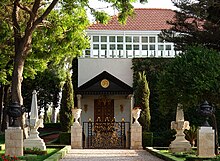Bahá'u'lláh
Appearance
Bahá'u'lláh | |
|---|---|
 Bahá'u'lláh Shrine | |
| Born | Mírzá Ḥusayn-`Alí Núrí[a] 12 November 1817 Tehran, Persie (present-day Iran) |
| Dee'd | 29 May 1892 (aged 74) Acre, Ottoman Empire (present-day Israel) |
| Kent for | Foonder o the Bahá'í Faith |
| Successor | `Abdu'l-Bahá |
Bahá'u'lláh (Arabic: بهاء الله, "Glory o God"; 12 November 1817 – 29 Mey 1892 an Muharram 2, 1233 - Dhu'l Qa'dah 2, 1309), born Mírzá Ḥusayn-`Alí Núrí (Persie: میرزا حسینعلی نوری), wis the foonder o the Bahá'í Faith. He claimed tae be the prophetic fulfilment o Bábism, a 19t-century ootgrowth o Shí‘ism,[1] but in a broader sense claimed tae be a messenger frae God referrin tae the fulfilment o the eschatological expectations o Islam, Christianity, an ither major releegions.[2]
Notes
[eedit | eedit soorce]References
[eedit | eedit soorce]- ↑ Smith 2008, p. 3
- ↑ Buck 2004, pp. 143–178
- Soorces
- Buck, Christopher (2004). "The eschatology of Globalization: The multiple-messiahship of Bahā'u'llāh revisited". In Sharon, Moshe (ed.). Studies in Modern Religions, Religious Movements and the Bābī-Bahā'ī Faiths. Boston: Brill. pp. 143–178. ISBN 90-04-13904-4.CS1 maint: ref=harv (link)
- Smith, Peter (2008). An Introduction to the Baha'i Faith. Cambridge: Cambridge University Press. ISBN 0-521-86251-5.CS1 maint: ref=harv (link)
